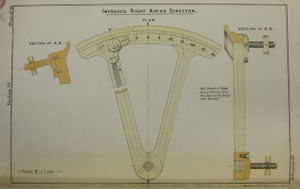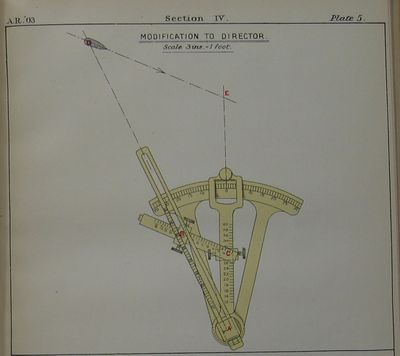Torpedo Director Pattern 1193: Difference between revisions
No edit summary |
|||
| Line 1: | Line 1: | ||
[[File: | [[File:ARTS1893Plate21.jpg|thumb|300px| '''Possible Pattern 1193 Refinement of 1893'''{{ARTS1893|Plate 21. I am inferring that this is an 1193. See also [[File:ARTS1893Plate20.jpg}Plate 20]]}}]] | ||
[[File:ARTS1903Plate5.jpg|thumb|400px| Graduated sighting bar added in 1903 for range determination{{ARTS1903|Plate 5. Small chance this is 2390. It cannot be an 1895, as they never had graduated sight bars}}]] | |||
The '''Torpedo Director Pattern 1193''', sometimes called the "Right Ahead" director,<ref>''Handbook of Torpedo Control, 1916'', p. 16.</ref> was a British [[Torpedo Director|torpedo director]] used in early torpedo craft. It was used for torpedoes fired from fixed tubes and from dropping gear.{{TorpDB1905|p. 376}} | |||
==Design== | ==Design== | ||
It | It was a contemporary instrument to the [[Torpedo Director Pattern 1192|Pattern 1192]] whose semi-circular design was amenable for use with trainable torpedo tubes.{{INF}} | ||
If a Pattern 1193a existed, it was similar, but made stronger in its pivots and sighting bar. | It featured a 60 degree arc. | ||
If a Pattern 1193a existed, it was similar, but made stronger in its pivots and sighting bar.{{TorpDB1914|p. 564}} | |||
==Alterations and Service== | ==Alterations and Service== | ||
It entered service sometime before | It entered service sometime before 1893, when its etchings were altered to permit torpedo speeds up to 40 knots and enemy ship speeds of up to 30 knots, from some lower figures as yet undiscovered.{{ARTS1893|p. 66, Plates 20, 21}} | ||
In 1911, it was described as for use by torpedo craft with cold torpedoes and when mounted right on the tube.<ref>''Addenda (1911) to Torpedo Manual, Vol. III., 1909'', p. 170.</ref> | |||
It was no longer used in any modern ships as of 1912. | It was no longer used in any modern ships as of 1912.{{TorpDB1912|p. 494}} | ||
In 1903, it is likely that the sight bar was etched with a scale to permit maximum range for firing to be calculated by arithmetic. | In 1903, it is likely that the sight bar was etched with a scale to permit maximum range for firing to be calculated by arithmetic.{{ARTS1903|Plate 5}} | ||
In 1909, some were fitted with [[Tangent Bar|tangent bars]] and regraduated to 2/3rd scale for use from TBD fore bridges and heater torpedoes. | In 1909, some were fitted with [[Tangent Bar|tangent bars]] and regraduated to 2/3rd scale for use from TBD fore bridges and heater torpedoes.{{ARTS1909|p. 22}} | ||
==See Also== | ==See Also== | ||
Latest revision as of 20:58, 24 November 2012


The Torpedo Director Pattern 1193, sometimes called the "Right Ahead" director,[3] was a British torpedo director used in early torpedo craft. It was used for torpedoes fired from fixed tubes and from dropping gear.[4]
Design
It was a contemporary instrument to the Pattern 1192 whose semi-circular design was amenable for use with trainable torpedo tubes.[Inference]
It featured a 60 degree arc.
If a Pattern 1193a existed, it was similar, but made stronger in its pivots and sighting bar.[5]
Alterations and Service
It entered service sometime before 1893, when its etchings were altered to permit torpedo speeds up to 40 knots and enemy ship speeds of up to 30 knots, from some lower figures as yet undiscovered.[6]
In 1911, it was described as for use by torpedo craft with cold torpedoes and when mounted right on the tube.[7]
It was no longer used in any modern ships as of 1912.[8]
In 1903, it is likely that the sight bar was etched with a scale to permit maximum range for firing to be calculated by arithmetic.[9]
In 1909, some were fitted with tangent bars and regraduated to 2/3rd scale for use from TBD fore bridges and heater torpedoes.[10]
See Also
Footnotes
- ↑ Annual Report of the Torpedo School, 1893. Plate 21. I am inferring that this is an 1193. See also [[File:ARTS1893Plate20.jpg}Plate 20]].
- ↑ Annual Report of the Torpedo School, 1903. Plate 5. Small chance this is 2390. It cannot be an 1895, as they never had graduated sight bars.
- ↑ Handbook of Torpedo Control, 1916, p. 16.
- ↑ Torpedo Drill Book, 1905. p. 376.
- ↑ Torpedo Drill Book, 1914. p. 564.
- ↑ Annual Report of the Torpedo School, 1893. p. 66, Plates 20, 21.
- ↑ Addenda (1911) to Torpedo Manual, Vol. III., 1909, p. 170.
- ↑ Torpedo Drill Book, 1912. p. 494.
- ↑ Annual Report of the Torpedo School, 1903. Plate 5.
- ↑ Annual Report of the Torpedo School, 1909. p. 22.
Bibliography